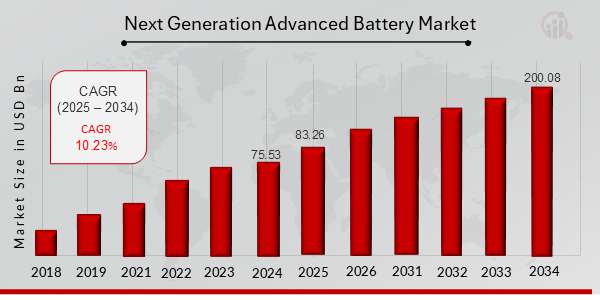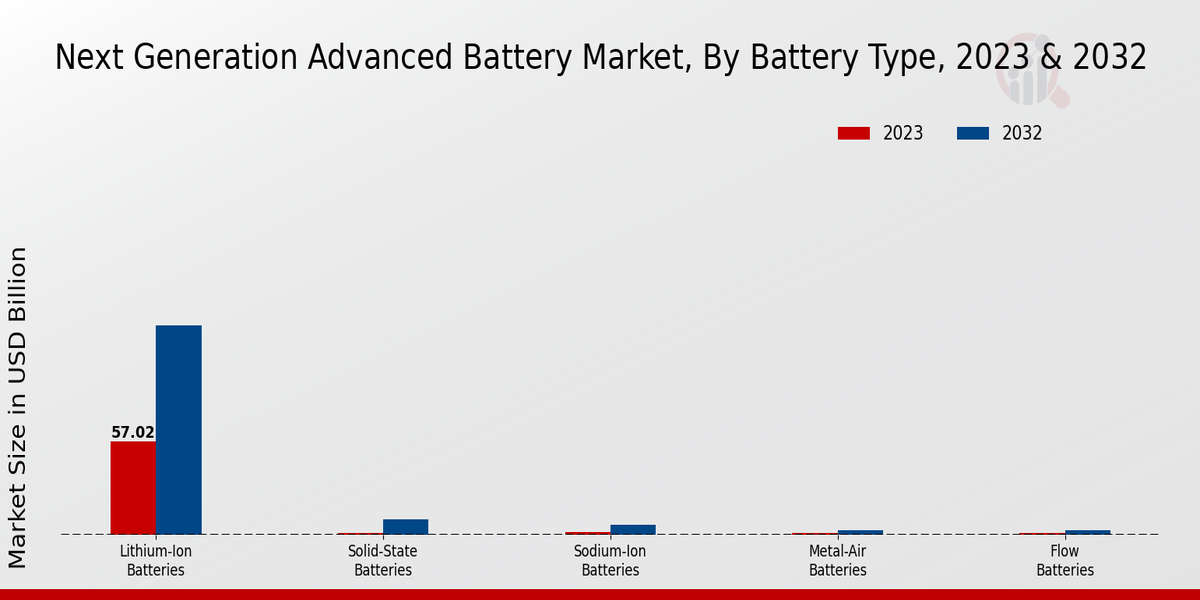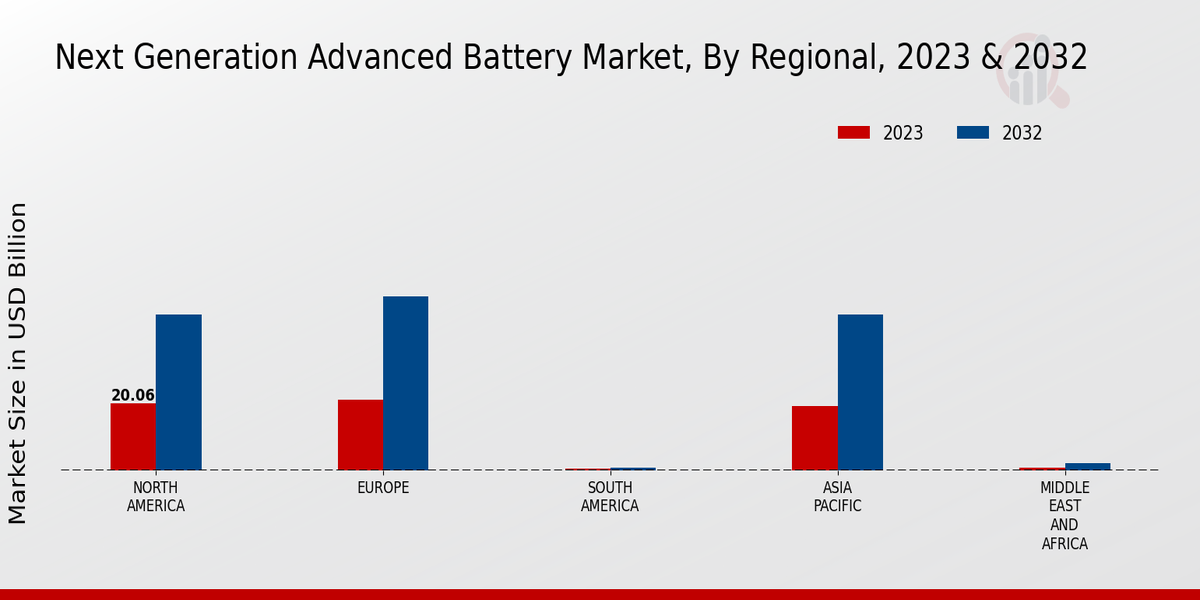Global Next Generation Advanced Battery Market Overview:
As per MRFR analysis, the Next Generation Advanced Battery Market Size was estimated at 75.53 (USD Billion) in 2024. The Next Generation Advanced Battery Market Industry is expected to grow from 83.26 (USD Billion) in 2025 to 200.08 (USD Billion) till 2034, at a CAGR (growth rate) is expected to be around 10.23% during the forecast period (2025 - 2034).
Key Next Generation Advanced Battery Market Trends Highlighted
The worldwide advanced battery market is linked to the increasing need for electric automobiles, portable electronic gadgets, and renewable energy storage systems. Factors contributing to market growth include more widespread use of electric mobility, clean energy promotion policies from the government, and a strong requirement for power solutions that are efficient and less harmful to the environment. The market offers prospects for the expansion of high energy-dense batteries, solid-state batteries and electric fast charging systems.
The usage of artificial intelligence and machine learning technologies in battery management systems offers good prospects for battery performance and service life improvement. Growing rapidly is the market for materials with recyclable and sustainable potential for manufacturing batteries due to ecology as well as regulation-related needs. Current trends in the market include the development of solid-state batteries with improved safety and efficiency, the introduction of graphene batteries with super-fast charging, and the rising penetration of wireless charging of batteries. Such ideas are expected to transform the allocation of battery storage technology development and production in the energy storage industry, turning out several compact and efficient batteries with large capacity and long-lasting usage.

Source: Primary Research, Secondary Research, MRFR Database and Analyst Review
Next Generation Advanced Battery Market Drivers
Rising Demand for Electric Vehicles
The growing adoption of electric vehicles (EVs) is a major driver of the Next Generation Advanced Battery Market Industry. As countries around the world implement stricter emissions regulations and consumers become more environmentally conscious, the demand for EVs is expected to continue to increase. Advanced batteries are essential for EVs, as they provide the power and range that consumers demand. The increasing popularity of EVs is, therefore, creating a strong demand for advanced batteries.
Government Support for Renewable Energy
In the current world, most of the governments around the world are offering substantial support to alternative resources of energy in particular solar and wind power. This is normally done in the form of grants, tax exemptions and other incentives since the use of RES renewable energy sources or alternative resources of energy is gaining firm ground and is becoming increasingly served by the progress of technology, which makes them commodities available at competitive prices.
The more competitive the renewable installations, the higher the demand for advanced batteries, which would store the excess of energy produced and, subsequently, supply it when shortfall would occur hence balancing the electric grid and making the renewable installations more reliable.
Technological Advancements
Also, the Next Generation Advanced Battery Market Industry is driven by technological advancements. Research and Development activities have been leading to the discovery of new battery technologies, which are more efficient and powerful and, more importantly, less costly. Advancements are also making advanced batteries more efficient for a broader range of applications. For example, batteries can be used in Electric Vehicles, Grid storage or portable devices.
Next Generation Advanced Battery Market Segment Insights:
Next Generation Advanced Battery Market Battery Type Insights
The Next Generation Advanced Battery Market is segmented by Battery Type into Lithium-ion Batteries, Solid-state Batteries, Sodium-ion Batteries, Metal-air Batteries, and Flow Batteries. Among these, Lithium-ion Batteries held the largest market share in 2023 and are expected to continue dominating the market throughout the forecast period. The high energy density and low self-discharge rate of Lithium-ion Batteries make them suitable for various applications, including electric vehicles, consumer electronics, and grid storage. Solid-state Batteries are expected to witness significant growth during the forecast period due to their higher energy density and improved safety compared to Lithium-ion Batteries.
However, the high cost and limited production capacity of Solid-state Batteries are currently hindering their widespread adoption. Sodium-ion Batteries are gaining attention as a potential alternative to Lithium-ion Batteries due to their lower cost and higher abundance of sodium compared to lithium. The development of new electrode materials and electrolytes is expected to drive the growth of the Sodium-ion Battery market in the coming years. Metal-air Batteries have the potential to offer even higher energy densities than Lithium-ion Batteries, making them suitable for long-range electric vehicles and grid storage applications.
However, the challenges associated with the stability and durability of Metal-air Batteries need to be addressed for their widespread adoption. Flow Batteries are gaining traction as a cost-effective and scalable solution for grid storage applications. The long lifespan and high round-trip efficiency of Flow Batteries make them suitable for storing large amounts of energy over extended periods. Overall, the Next Generation Advanced Battery Market is expected to witness significant growth over the forecast period, driven by increasing demand for electric vehicles, renewable energy storage, and grid modernization.The development of new technologies and the reduction in production costs are expected to further accelerate the adoption of Next Generation Advanced Batteries in the coming years.

Source: Primary Research, Secondary Research, MRFR Database and Analyst Review
Next Generation Advanced Battery Market Application Insights
The Application segment of the Next Generation Advanced Battery Market is anticipated to continue its robust growth trajectory over the forecast period. The surge in market growth is primarily attributed to the increasing adoption of electric vehicles (EVs), coupled with the growing demand for energy storage systems. The EV segment is poised to dominate the Application segment throughout the forecast period. In 2023, the EV segment is expected to capture a significant share of the market, owing to the rising popularity of EVs and the growing need for high-performance batteries to power these vehicles.
The energy storage systems segment is anticipated to exhibit steady growth, driven by the increasing demand for reliable and efficient energy storage solutions for renewable energy applications, such as solar and wind power. Wearable devices, power tools, and medical devices are other notable segments in the Application segment. Wearable devices, such as smartwatches and fitness trackers, are becoming increasingly popular, driving the demand for miniaturized and long-lasting batteries. Power tools, including drills and saws, are also witnessing growing demand for advanced batteries that offer extended runtime and durability.Medical devices, such as pacemakers and insulin pumps, require reliable and compact batteries to ensure continuous operation.
Next Generation Advanced Battery Market Electrochemical System Insights
The electrochemical system segment is witnessing significant advancements and is expected to drive the growth of the Global Next Generation Advanced Battery Market. Aqueous-based systems, non-aqueous-based systems, and solid-state systems are the primary electrochemical systems used in advanced batteries. Aqueous-based systems, with a market revenue of USD 34.9 billion in 2023, offer advantages such as low cost, high safety, and environmental friendliness. Non-aqueous-based systems, projected to reach USD 56.3 billion by 2032, provide high energy density and improved performance.
Solid-state systems, though still in the early stages of development, hold immense potential due to their enhanced safety, longer lifespan, and wider temperature range. These electrochemical systems are poised to revolutionize various industries, including consumer electronics, electric vehicles, and grid energy storage, driving the overall growth of the Global Next Generation Advanced Battery Market.
Next Generation Advanced Battery Market Manufacturing Technology Insights
The Next Generation Advanced Battery Market segmentation by Manufacturing Technology into Battery Cell Manufacturing, Battery Pack Assembly, and Battery Management System Integration offers valuable insights into the industry's dynamics. Battery Cell Manufacturing, accounting for USD 15.2 billion in 2023, holds the largest revenue share due to the increasing demand for high-performance and long-lasting batteries. Battery Pack Assembly, estimated to reach USD 10.5 billion by 2024, showcases significant growth potential driven by the rising adoption of electric vehicles
.Battery Management System Integration, with a projected CAGR of 12.1%, is expected to contribute significantly to the overall market growth, driven by the need for efficient battery management and safety. These insights are crucial for understanding the competitive landscape and identifying growth opportunities in the Global Next Generation Advanced Battery Market.
Next Generation Advanced Battery Market End-User Industry Insights
The Next Generation Advanced Battery Market is segmented by End-User Industry into Automotive, Industrial, Consumer Electronics, Healthcare, and Aerospace. Among these segments, the Automotive segment is expected to hold the largest share of the market in 2023, and it is projected to continue to dominate the market throughout the forecast period. The growth of the Automotive segment is primarily driven by the increasing demand for electric vehicles and the need for more efficient and powerful batteries in these vehicles. The Industrial segment is also expected to witness significant growth during the forecast period as advanced batteries are increasingly used in industrial applications such as robotics, automation, and energy storage.
The Consumer Electronics segment is another major segment of the market, and it is expected to grow at a steady pace during the forecast period. The demand for advanced batteries in consumer electronics devices such as smartphones, laptops, and tablets is driving the growth of this segment. The Healthcare segment is also expected to witness notable growth as advanced batteries are increasingly used in medical devices and equipment. The Aerospace segment is expected to grow at a slower pace compared to other segments, as the demand for advanced batteries in aerospace applications is relatively niche.
Next Generation Advanced Battery Market Regional Insights
The regional landscape of the Next Generation Advanced Battery Market exhibits significant growth potential across key regions. North America holds a dominant position, capturing a sizeable market share due to the presence of leading automotive manufacturers and robust government support for electric vehicle adoption. Europe follows closely, driven by stringent emission regulations and a growing focus on sustainability. Asia-Pacific (APAC) is projected to witness the fastest growth rate, fueled by increasing demand for electric vehicles in China, Japan, and South Korea.
South America and the Middle East and Africa (MEA) regions are expected to contribute to the overall market growth, albeit at a slower pace, as they continue to develop their electric vehicle infrastructure and regulatory frameworks. The Next Generation Advanced Battery Market is expected to reach $74.58 billion in 2024, with a projected CAGR of 10.23% during the forecast period (2023-2032).

Source: Primary Research, Secondary Research, MRFR Database and Analyst Review
Next Generation Advanced Battery Market Key Players And Competitive Insights:
The Next Generation Advanced Battery Market is dominated by major players that are advancing and developing technologies to meet the increasing demand for advanced batteries. In order to stay relevant, leading Next Generation Advanced Battery Market companies, such as Samsung SDI, LG Chem, Panasonic, BYD, and others, are investing in research and development. The turning point in the development of the Next Generation Advanced Battery Market was triggered by the increasing popularity of electric vehicles, which require efficient batteries offering long life and high charging and discharging rates.
Both new entrants and incumbents will compete for market share, and as such, the competitive landscape of the Next Generation Advanced Battery Market will be in a state of flux. In turn, the first-mover advantage will benefit the companies that have already heavily invested in research and development. For example, one of the major Chinese companies producing lithium-ion batteries is Contemporary Amperex Technology Co., Limited. The competitive advantage of the company lies in its developed technology and well-established partnerships. In the case of CATL, it is easily noted that it will continue to be a leader in the Next Generation Advanced Battery Market. Samsung SDI is another prime example of a company that will remain a player in the market. The company is one of the oldest in the battery production sector and is a subsidiary of Samsung Electronics. It has a long and successful track of producing batteries ranging from lithium ion, polymer, and iron phosphate to solid state and ultracapacitors.
Key Companies in the Next Generation Advanced Battery Market Include:
- Toshiba
- BYD Company Ltd.
- AMARON
- Samsung SDI Co., Ltd.
- Exide Industries Limited
- Contemporary Amperex Technology Co., Ltd.
- Hitachi
- SK Innovation Co., Ltd.
- Godrej Boyce
- LG Chem, Ltd.
- Panasonic Corporation
- FIAMM
- A123 Systems LLC
- CATL
Next Generation Advanced Battery Market Industry Developments
Recent developments in the global next-generation advanced battery market include a surge in investments in research and development, driven by the growing demand for electric vehicles and renewable energy storage systems. Key players such as Tesla, Panasonic, and LG Chem are expanding their production capacities to meet the increasing demand. Governments worldwide are implementing supportive policies and regulations to promote the adoption of advanced battery technologies.
For instance, the European Union has set a target of having 30 million electric vehicles on the road by 2030. Additionally, advancements in battery chemistry, such as the development of solid-state batteries, are expected to further enhance the performance and affordability of next-generation advanced batteries.
Next Generation Advanced Battery Market Segmentation Insights
-
Next Generation Advanced Battery Market Battery Type Outlook
- Lithium-ion Batteries
- Solid-state Batteries
- Sodium-ion Batteries
- Metal-air Batteries
- Flow Batteries
-
Next Generation Advanced Battery Market Application Outlook
- Electric Vehicles
- Energy Storage Systems
- Wearable Devices
- Power Tools
- Medical Devices
-
Next Generation Advanced Battery Market Electrochemical System Outlook
- Aqueous-based Systems
- Non-aqueous-based Systems
- Solid-state Systems
-
Next Generation Advanced Battery Market Manufacturing Technology Outlook
- Battery Cell Manufacturing
- Battery Pack Assembly
- Battery Management System Integration
-
Next Generation Advanced Battery Market End-User Industry Outlook
- Automotive
- Industrial
- Consumer Electronics
- Healthcare
- Aerospace
-
Next Generation Advanced Battery Market Regional Outlook
- North America
- Europe
- South America
- Asia Pacific
- Middle East and Africa
| Report Attribute/Metric |
Details |
|
Market Size 2024
|
75.53 (USD Billion)
|
|
Market Size 2025
|
83.26 (USD Billion)
|
|
Market Size 2034
|
200.08 (USD Billion)
|
|
Compound Annual Growth Rate (CAGR)
|
10.23% (2025 - 2034)
|
|
Report Coverage
|
Revenue Forecast, Competitive Landscape, Growth Factors, and Trends
|
|
Base Year
|
2024
|
|
Market Forecast Period
|
2025 - 2034
|
|
Historical Data
|
2019 - 2023
|
| Market Forecast Units |
USD Billion |
| Key Companies Profiled |
Toshiba, BYD Company Ltd., AMARON, Samsung SDI Co., Ltd., Exide Industries Limited, Contemporary Amperex Technology Co., Ltd., Hitachi, SK Innovation Co., Ltd., Godrej Boyce, LG Chem, Ltd., Panasonic Corporation, FIAMM, A123 Systems LLC, CATL |
| Segments Covered |
Battery Type, Application, Electrochemical System, Manufacturing Technology, End-User Industry, Regional |
| Key Market Opportunities |
Demand for Electric Vehicles Innovations in GrapheneBased Batteries Growing Renewable Energy Storage Integration with IoT |
| Key Market Dynamics |
Growing electric vehicle sales, government incentives, technological advancements, increasing demand for renewable energy storage, and expanding battery RampD |
| Countries Covered |
North America, Europe, APAC, South America, MEA |
Frequently Asked Questions (FAQ) :
The Next Generation Advanced Battery Market is expected to reach a valuation of USD 200.08 billion by 2034, expanding at a CAGR of 10.23% from 2025 to 2034.
Asia-Pacific is anticipated to dominate the Next Generation Advanced Battery Market owing to the increasing demand for electric vehicles and the presence of major battery manufacturers in the region.
Electric vehicles are projected to be the primary application segment, accounting for a substantial share of the Next Generation Advanced Battery Market. The rising adoption of electric vehicles is attributed to government initiatives promoting clean energy and consumer awareness regarding environmental sustainability.
Prominent players in the Next Generation Advanced Battery Market include CATL, BYD, Panasonic, LG Energy Solution, Samsung SDI, and Tesla. These companies are investing heavily in research and development to enhance battery performance and reduce costs.
The Next Generation Advanced Battery Market is witnessing advancements in solid-state batteries, which offer higher energy density and improved safety compared to traditional lithium-ion batteries. Additionally, the integration of artificial intelligence and machine learning is optimizing battery management systems, leading to enhanced battery performance and lifespan.
The Next Generation Advanced Battery Market faces challenges related to raw material availability, particularly for critical materials like lithium and cobalt. Moreover, ensuring the safe and sustainable disposal of batteries remains a concern.
Government regulations play a crucial role in driving the adoption of Next Generation Advanced Batteries. Governments worldwide are implementing policies and incentives to promote the use of electric vehicles and support the development of battery technologies.
The Next Generation Advanced Battery Market is anticipated to experience significant growth in the coming years. The increasing demand for electric vehicles, coupled with advancements in battery technology and government support, is expected to fuel market expansion.
The Next Generation Advanced Battery Market presents opportunities for innovation in battery materials, designs, and manufacturing processes. Companies can capitalize on the growing demand for high-performance, cost-effective, and sustainable batteries.
The growth of the Next Generation Advanced Battery Market is driven by factors such as the increasing adoption of electric vehicles, the need for improved battery performance and efficiency, and government initiatives promoting clean energy technologies.

















